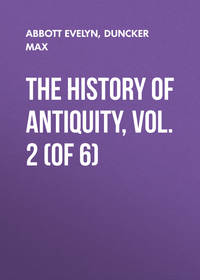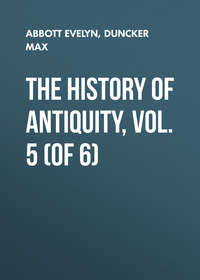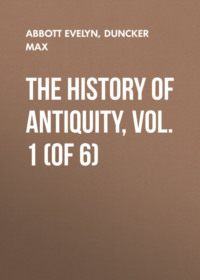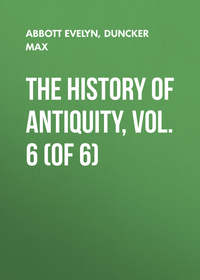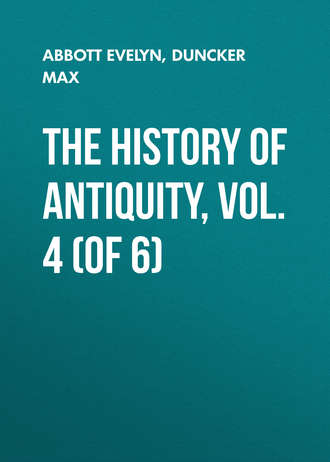 полная версия
полная версияThe History of Antiquity, Vol. 4 (of 6)
CHAPTER III.
THE CONQUEST OF THE LAND OF THE GANGES
The life of the Aryas in the Panjab was manly and warlike. From the songs of the Rigveda we saw how familiar they were with the bow and the chariot, how frequent were the feuds between the princes, and the prayers offered to the gods for victory. Such a life could, no doubt, increase the pleasure in martial achievements, and lead to further enterprises, even if the plains and pastures of the Panjab had not been too narrow for the inhabitants. We remember the prayer in which the war-god was invoked to grant the Arian tribes room against the black-skins (p. 8). As a fact the Aryas extended their settlements to the East beyond the Sarasvati; and as on the lower Indus the broad deserts checked any progress towards the region of the Yamuna and the Ganges, the advance from the Sarasvati to the Yamuna must have taken place in the North along the spurs of the Himalayas.
From the hymns of the Rigveda we can ascertain that the Arian tribes pressed on each other, and that the tribes settled in the East were pushed forward in that direction by tribes in the West. Ten tribes of the Panjab, who appear to have occupied the region of the Iravati,120– the Bharatas, Matsyas, Anus, and Druhyus, are specially mentioned among them – united for a campaign against king Sudas, the son of Divodasa, the descendant of Pijavana, who ruled over the Tritsus on the Sarasvati. On the side of the united tribes was the priest Viçvamitra of the race of the Kuçikas; on the side of the Tritsus the family of Vasishtha.121 The Bharatas, Matsyas, Anus, and Druhyus, must have crossed the Vipaça and the Çatadru in order to attack the Tritsus. The Rigveda mentions a prayer addressed by Viçvamitra to these two streams. "Forth from the slopes of the mountains; full of desire, like horses loosed in the course, like bright-coloured cows to their calves, Vipaça and Çatadru hasten with their waves. Impelled by Indra, seeking an outlet to the sea, ye roll onward like warriors in chariots of war: in united course with swelling waves ye roll into each other, ye clear ones. Listen joyfully to my pleasant speech, for a moment. O abounding in waters, halt on your steps to the sea. With strong earnestness, crying for help, I entreat you, I, the son of Kuçika. Listen to the minstrel, ye sisters; he has come from far with horse and chariot. Incline yourselves, that ye may be crossed; your waves, ye streams, must not reach the axles. When the Bharatas have crossed you, the mounted host, goaded by Indra, then run on in your renewed course." After the two rivers were crossed a battle took place. Viçvamitra uttered the prayer for the Bharatas: "Indra, approach us with manifold choice help; great hero, be friendly. May he who hates us fall at our feet; may he whom we hate, be deserted by the breath of life. As the tree falls beneath the axe, as a man breaks asunder a husk, as a boiling kettle throws off the foam, so deal thou, O Indra, with them. These sons of Bharata, O Indra, know the battle. They spur their horses; they carry the strong bow like an eternal enemy, looking round in the battle."122
In spite of the prayer of Viçvamitra the Bharatas and their confederates were defeated; Sudas was even able to invade their land, to capture and plunder several places. The song of victory of the Tritsus, which a minstrel of Sudas may have composed after their success, runs thus: "Two hundred cows, two chariots with women, allotted as booty to Sudas, I step round with praises, as the priests step round the place of sacrifice. To Sudas Indra gave the flourishing race of his enemies, the vain boasters among men. Even with poor men Indra has done marvellous deeds; by the weak he has struck down the lion-like. With a needle Indra has broken spears; all kinds of good things he has given to Sudas. Ten kings, holding themselves invincible in battle, could not strive against Sudas, Indra, and Varuna; the song of them who brought food-offerings was effectual. Where men meet with raised banner in the battle-field, where evil of every kind happens, where all creatures are afraid, there have ye, Indra and Varuna, spoken (words of) courage above us, as we looked upwards. The Tritsus in whose ranks Indra entered went onward like downward streaming water: their enemies, like hucksters when dealing, leave all their goods to Sudas. As Sudas laid low twenty-one enemies in glorious strife, as the sacrificer strews holy grass on the place of sacrifice, so did Indra the hero pour out the winds. Sixty hundred of the mounted Anus and Druhyus perished; sixty and six heroes fell before the righteous Sudas. These are the heroic deeds, all of which Indra has done. Without delay, Indra destroyed all the fortresses of the enemy, and divided the goods of the Anus in battle to the Tritsus. The four horses of Sudas, the coursers worthy of praise, richly adorned, stamping the ground, will bring race against race to glory. Ye strong Maruts, be gracious to him as to his father Divodasa, preserve to him the house of Pijavana, and let the power of the righteous king continue uninjured." In another song of the Rigveda the glory of this victory of king Sudas is especially ascribed to Vasishtha and his sons "in white robes with the knot on the right side" (p. 29). They were seen surrounded in the battle of the ten kings, then Indra heard Vasishtha's song of praise, and the Bharatas were broken like the staffs of the ox-driver. The Vasishthas had brought the mighty Indra from far by their soma-offering, by the power of their prayer; then had Indra given glory to the Tritsus, and their tribes had extended.123
The extension of the Aryas in the rich plains of the Yamuna and the Ganges must in the first place have followed the course of the former river towards the south, and then reached over the land between the two rivers, until the immigrants arrived further and further to the east on the banks of the Ganges. We have no historical information about the facts of these migrations and conquests, of the occupation of the valleys of the Yamuna, the upper and middle Ganges; we can only ascertain that the valley of the Yamuna, and the doab of the two rivers were first occupied and most thickly colonised. It is not till we come lower down the course of the Ganges, that we find a large number of the old population in a position of subjection to the Arian settlers. Lastly, as we learn from the Indian Epos, the Aryas had not merely to contend against the old population at the time of their settlement; nor did they merely press upon one another, while those who came last sought to push forward the early immigrants, as we concluded to be the case from the hymns quoted from the Rigveda; they also engaged in conflicts among themselves for the possession of the best land between the Yamuna and the Ganges. In these struggles the tribes of the immigrants became amalgamated into large communities or nations, and the successful leaders found themselves at the head of important states. The conquest and colonisation of such large regions, the limitation and arrangement of the new states founded in them, could only be accomplished in a long space of time. According to the Epos and the Puranas, i. e. the very late and untrustworthy collections of Indian legends and traditions, it was after a great war among the Aryas in the doab of the Yamuna and Ganges, in which the family of Pandu obtained the crown of the Bharatas on the upper Ganges, that the commotion ceased, and the newly founded states enjoyed a state of peace. In the Rigveda, the Bharatas are to the west of the Vipaça, in the Epos we find them dwelling on the upper Ganges; on the Yamuna are settled the nations of the Matsyas, and the Yadavas; between the upper Yamuna and the Ganges are the Panchalas, i. e. the five tribes; eastward of the Bharatas on the Sarayu, down to the Ganges, are the Koçalas. Still further to the east and north of the Ganges are the Videhas; on the Ganges itself are the Kaçis and the Angas, and to the south of the Ganges the Magadhas.
Are we in a position to fix even approximately the period at which the settlement of the Aryas in the valley of the Ganges took place, and the struggles connected with this movement came to an end? The law-book of the Indians tells us that the world has gone through four ages; the age of perfection, Kritayuga; the age of the three fires of sacrifice, i. e. of the complete observance of all sacred duties, Tritayuga; the age of doubt, Dvaparayuga, in which the knowledge of divine things became obscured; and lastly the age of sin, the present age of the world, Kaliyuga. Between the end of one period and the beginning of the next there came in each case a period of dimness and twilight. If this period is reckoned in, the first age lasted 4800 divine years, or 1,728,000 human years; the life of men in this age reached 400 years. The second age lasted 3600 divine years, or 1,296,000 human years, and life reached 300 years. The third age lasted 2400 divine years, or 864,000 human years, and men only lived to the age of 200 years. The present age will last 1200 divine years, or 432,000 human years, and men will never live beyond the age of 100 years.124 This scheme is obviously an invention intended to represent the decline of the better world and the increase of evil, in proportion to the distance from the divine origin. In the matter of numbers the Indians are always inclined to reckon with large figures, and nothing is gained by setting forth the calculations in greater detail. From the Rigveda it is clear that the year of the Indians contained 360 days in twelve months of 30 days. In order to bring this year into accordance with the natural time, a month of thirty days was inserted in each fifth year as a thirteenth month although the actual excess in five years only amounted to 26¼ days. Twelve of these cycles of five years were then united into a period of 60 years, i. e. 12 x 5, and both the smaller and the larger periods were called Yuga.125 On this analogy the world-periods were formed. By multiplying the age of sin by ten we get the whole duration of the world; the perfect age is four times as long as the age of sin.126 A year with the gods is as long as a day with men; hence a divine year contains 360 years of men, and the world-period, i. e. the great world-year, is completed in 12 cycles each of 1000 divine years, i. e. 360,000 human years. In the first age, the age of perfection, Yama and Manu walked and lived on earth with their half-divine companions (p. 30); in the age of the three fires of sacrifice, i. e. of the strict fulfilment of sacred duties, lived Pururavas, who kindled the triple sacrificial fire,127 and the great sacrificers or minstrels, the seven or ten Rishis (p. 29 n. 2); the period of darkness and doubt was the age of the great heroes. With the priests who invented this system of ages the period of the great heroes was naturally placed lower than that of the great sacrificers and saints. The historical value attaching to this scheme lies in the fact that the Epos places the great war of the Pandus and Kurus in the period of transition between the age of doubt and the age of evil, in the twilight of the Kaliyuga, and the Puranas in consequence make the beginning of the reign of the first Pandu over the Bharatas after the great war, the accession of Parikshit, coincide with the commencement of the Kaliyuga.128 Now according to the date of the Puranas the Kaliyuga begins in the year 3102 B.C. On this calculation the great movement towards the east and in the east came to an end about this time.
That the Indians once contented themselves with smaller numbers in fixing the ages than those which we find in the book of the law and the Puranas, we may conclude from the statements of the Greek Megasthenes, who drew up his account at the court of Chandragupta (Sandrakottos) of Magadha at the end of the fourth century B.C. This author tells us that in ancient times the Indians were nomads, clothed in the skins of animals, and eating raw flesh, till Dionysus came to them and taught them the tillage of the field, the care of vines, and the worship of the gods. On leaving India he made Spatembas king, who reigned 52 years; after him his son Budyas reigned for 20 years, who was in turn succeeded by his son Kradeuas, and so the sceptre descended from father to son; but if a king died without children the Indians selected the best man to be king. From Dionysus to Sandrakottos the Indians calculated 153 kings, and 6402 years. In this period the line had been broken three times; the second interruption lasted 300 years, the third 120 years.129 What particular rite among the Indians caused the Greeks to represent Dionysus as visiting India and to make him the founder of Indian civilisation, will become clear further on. Putting this aside, the account of Megasthenes of the triple break in the series of kings shows that the system of the four ages was in vogue among the Indians even at that time. If Megasthenes speaks of a single line of Indian kings ruling over the whole of India from the very beginning, the reason is obviously that he transfers to the past the condition in which India was at the time when he abode on the Ganges. Chandragupta did what had never been done before; he united under his dominion all the regions of India from the Panjab to the mouth of the Ganges, from the Himalayas to the Vindhyas. But the close of this series of kings at which Sandrakottos is himself placed shows us plainly that the royal line of Megasthenes is no other than the royal line of Magadha. The Puranas of the Indians also carry back the line of Magadha to the ancient heroes, and through them to the progenitors of the nation. Spatembas, with whom the series of Indian kings commences in Megasthenes, may be the Manu Svayambhuva whom the cosmogonic systems of the priests had meanwhile placed before Manu Vaivasvata, the son of Vivasvat. Budyas the successor of Spatembas may have been the Budha of the Indians who is with them the father of Pururavas, the kindler of the triple fire of sacrifice: and Pururavas himself may be concealed under the Kradeuas of the manuscripts, which is possibly Prareuas, the Grecised form of the Indian name. However this may be, the statements of Megasthenes present us with far smaller and more intelligible numbers for the periods of Indian history than those obtained from Manu's book of the law and the Puranas.130
The year in which Chandragupta conquered Palibothra, and so ascended the throne of Magadha, can be fixed with accuracy from the accounts of western writers. It was the year 315 B.C. As 6042 years are supposed to elapse between Spatembas and the accession of Sandrakottos, Spatembas must have begun to reign over the Indians in the year 6717 B.C. But this date it is impossible to maintain. In the first place it is impossible that 153 reigns should have filled up a space of 6400 years. This would allow each king a reign of 42 years, or of about 38 years if we deduct 600 years for the three interruptions in the series. Moreover, the Indian lists of kings, at any rate as we now find them in the Epos and in the Puranas, present a smaller total of kings than 153, whether they come down to Chandragupta himself, or to his age. From Chandragupta to Brihadratha, the supposed founder of the race, the lists of the kings of Magadha give 53 kings according to the lesser total and 64 according to the larger. If to these lists we add the rulers who unite the kings of Magadha to the family of Kuru, and those who carry back the family of Kuru to Manu, we are still able to add no more than 28 or 38 kings according as we take the shorter or longer lists. Hence in these lists, instead of 153 kings, we get at most only 100, as reigning before Chandragupta. The list given in the Vishnu Purana for the kings of the Koçalas is somewhat longer; it enumerates 116 kings from Manu to Prasenajit, whose reign fills the interval between 600 and 550 B.C. If we add 10 or 14 reigns for the period between Prasenajit and the accession of Chandragupta, the longest of the lists preserved by the Indians would still only present 130 reigns before the time of Chandragupta.131
It is not clear from the account of Megasthenes, or at any rate from the excerpts which have come down to us, what was the extent of the period which elapsed between the last interruption in the list of kings and Sandrakottos. Hence we are not in a position to ascertain the duration of the fourth age, or Kaliyuga, as it was fixed among the Indians in his time; we must therefore have recourse to other proofs in order to discover whether the year given in the Puranas, 3102 B.C., may be taken for the commencement of a new period, i. e. the post-epic, or historic, in the valley of the Ganges. The fixed point from which we must start is the year of the accession of Sandrakottos, a date rendered certain by the accounts of the Greeks. In the period before this date, the lists of the Brahmans taken together with the lists of Buddhists carry back the series of the kings of Magadha, which was the most important kingdom on the Ganges long before Sandrakottos, with tolerable certainty as far as the year 803 B.C., i. e. to the beginning of the sway of the dynasty of the Pradyotas over Magadha.132
Can we ascend beyond this point? According to the Puranas, the race of the Barhadrathas had ruled over Magadha before the Pradyotas, from Somapi to Ripunjaya, the last of the family, and their sway had continued 1000 years. Of this family the Vayu-Purana enumerates 21 kings, and the Matsya-Purana 32 kings. This domination of a thousand years is obviously a round, cyclic sum: and both in the Vayu-Purana and the Matsya-Purana the total of the reigns given for the several rulers of this dynasty falls below the sum of 1000 years. If we take 25 years, the highest possible average for each reign, 21 reigns or 525 years will only bring us to the year 1328 B.C. (803 + 525). At this date, then, the Barhadrathas may have begun to reign over Magadha. If, on the other hand, we keep 32 as the number of these kings, and an average of only 15 years is allotted to the several reigns – an average usually correct in long lists of reigns in the East – we arrive at 1283 B.C. as the date of the beginning of the reign of the Barhadrathas (803 + 480). To this date, or near it, we come, if we test the lists of kings supplied by the Puranas for the series of the kings of the Koçalas and the Bharatas in the land of the Ganges. The time at which Prasenajit was king of the Koçalas can be fixed at the first half of the sixth century B.C. (see below). Before him the Vishnu-Purana gives a series of 23 kings down to the close of the great war. Twenty-three reigns, allowing an average of 25 years for each, carry us 575 years beyond the commencement of Prasenajit, i. e. up to 1175 B.C. (600 + 575). In the list of the rulers of Hastinapura, for which throne the great war was waged, Çatanika appears as the twenty-fourth successor of Parikshit, to whom, as we found, this throne fell, after the conclusion of the great war. As Çatanika died about the year 600 B.C. (cf. Book VI. chap, i.), 24 reigns of 25 years before him would bring us to the year 1200 B.C. as the beginning of the year of Parikshit. The statement of the Puranas that he ascended the throne in the year 3102 B.C. and that the Kaliyuga began with that year cannot therefore be maintained. And this date is contradicted not only by the results of an examination of the lists of the kings of Magadha, of the Koçalas and Bharatas, but also by a statement in the Vishnu-Purana. This tells us that, from the beginning of the Kaliyuga to the date when the first Nanda ascended the throne of Magadha, a period of 1015 years elapsed.133 The accession of this king we can place with tolerable certainty in the year 403 B.C.; and thus, even on the evidence of the Vishnu-Purana, the Kaliyuga began in the year 1418 B.C., and Parikshit ascended the throne of the Bharatas in that year. It is not impossible, therefore, that the 32 reigns which the Matsya-Purana gives to the Barhadrathas may have filled up the time from the year 1418 to the year 803 B.C. (615 years).134 Before the first Barhadrathas, Sahadeva, Jarasandha, and Brihadratha are said to have reigned over Magadha. Hence the foundation of the kingdom of Magadha would have to be placed, at the earliest, in the year 1480 B.C., and not earlier; but rather, if we follow the comparison of the parallel reigns as above, a century later. If the great movement towards the east and in the east was brought to an end at the accession of Parikshit and the commencement of the Kaliyuga in the year 1418 B.C., and thus in the course of the fifteenth or fourteenth century the foundation could be laid for the kingdom of Magadha, i. e. for a great civic community far to the east, the migration into the regions of the Yamuna and the upper Ganges must have commenced at the least about the year 1500 B.C. We have already referred to the fact that the colonisation of such extensive districts, the foundation and fortification of large kingdoms in them, which was moreover rendered still more difficult by severe contests among the immigrants, could not have been the work of a few decades of years.
If the immigration of the Aryas into the land of the Ganges took place about 1500 B.C. we should have a point whereby to fix the time at which the hymns of the Veda were composed, for in them, as has been already remarked, the Ganges is rarely mentioned. The great number of the hymns must therefore have received the form in which they were retained and handed down by the families of minstrels before the year 1500 B.C. The period of migration brought with it more serious and earnest tasks than had occupied the Aryas in the Panjab. The struggles against the old population, the wars of the newly-established states with one another, claimed the whole power of the emigrants. Hence the duties of the sacrificial songs or of hymns of thanksgiving were thrown into the background by the imperative necessities of the moment. Men were contented with the invocations of the gods which lived in the memory of the minstrel-families, and had been brought from the ancient home. The minstrels also, who led the emigrant princes and tribes, naturally gave their attention to songs of war and victory – songs of which the fragment preserved from the wars of the Bharatas against the Tritsus is an example (p. 67). When at length the period of emigration, of settlement, and struggle was over, with the advent of more peaceful times, the excitement of the moment gave place to reflection and to the remembrance of the great deeds of the ancestors. The inspired flights, the pressure of immediate feeling which had prompted the songs before the battle and after the victory, were followed by a more peaceful and narrative tone. Hence grew up a series of songs of the marvels and deeds of the heroes who had conquered the land in the Yamuna and Ganges, and had founded states and cities there. As the heroes and events thus celebrated passed into the background, as the intervening periods became wider, the greater was the tendency of this mass of song to gather round a few great names and incidents. The less prominent forms and struggles disappeared, and in the centuries which followed the strain of settlement and establishment an artificial culture of this warlike minstrelsy united the whole recollections of the heroic times into the narrative of the great war, the Mahabharata.
If we could present to ourselves this Epos of the Indians in the form which it may have assumed two or three centuries after the close of the great migrations and struggles, i. e. about the eleventh century B.C., it would still be a valuable source of historical knowledge. We could not indeed have taken the occurrences described in it as historical facts, without criticism, but we should have possessed a tradition of which the outline would have been approximately correct, and a description of manners historically true for the period when the poems arose and were thrown into shape – though untrue for the period depicted in the poem – after deducting what was due to the idealism of the poet. Unfortunately, repeated revisions and alterations have almost effaced the original lines; each new stage of civilisation attained by the Indians has eagerly sought to infuse its ideas and conceptions into the national tradition; older and later elements lie side by side often without any attempt at reconciliation, sometimes in direct opposition. The original warlike character of the poetry is forced into the background by the priestly point of view of a later age. In the poems in their present form there is none of that freshness of feeling and impression which is so vividly expressed in the prayers of the priests of the Bharatas, and the songs of the Tritsus; there is no immediate recollection at work. The effort to comprise all the stories and legends of the nation into a whole, to bring forward in these poems, as in a pattern and mirror of virtue, every lesson of religion and morals, and unite them into one great body of doctrine, has swelled the Indian Epos into a heavy and enormous mass, an encyclopædia, in which it is not possible without great labour to discover the connecting links of the narrative in the endless chaos of interpolations and episodes, the varying accounts of one and the same event. The Epos has thus become a tangle in which we cannot discover the original threads. It received its present form in the last centuries B.C.135


